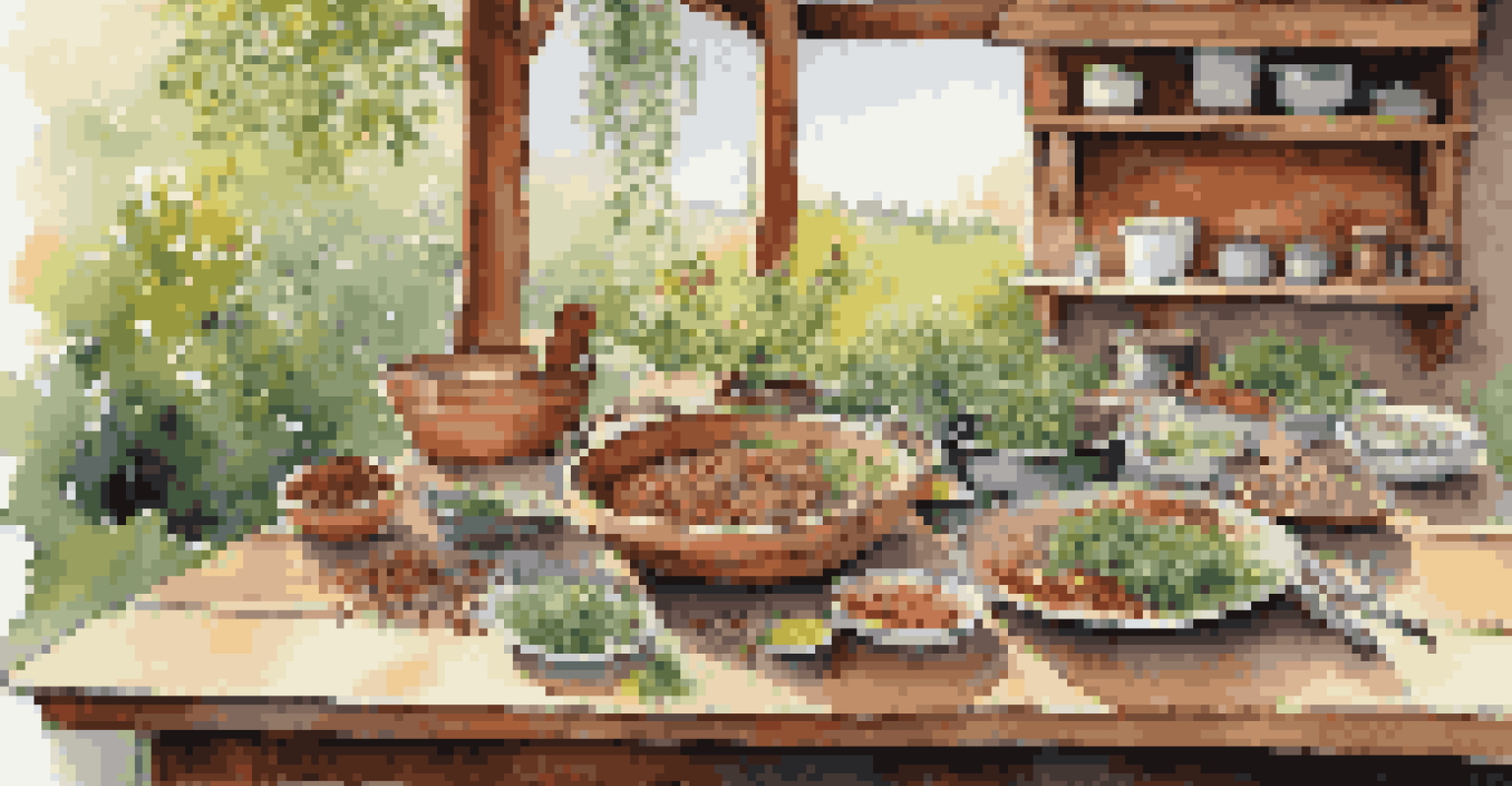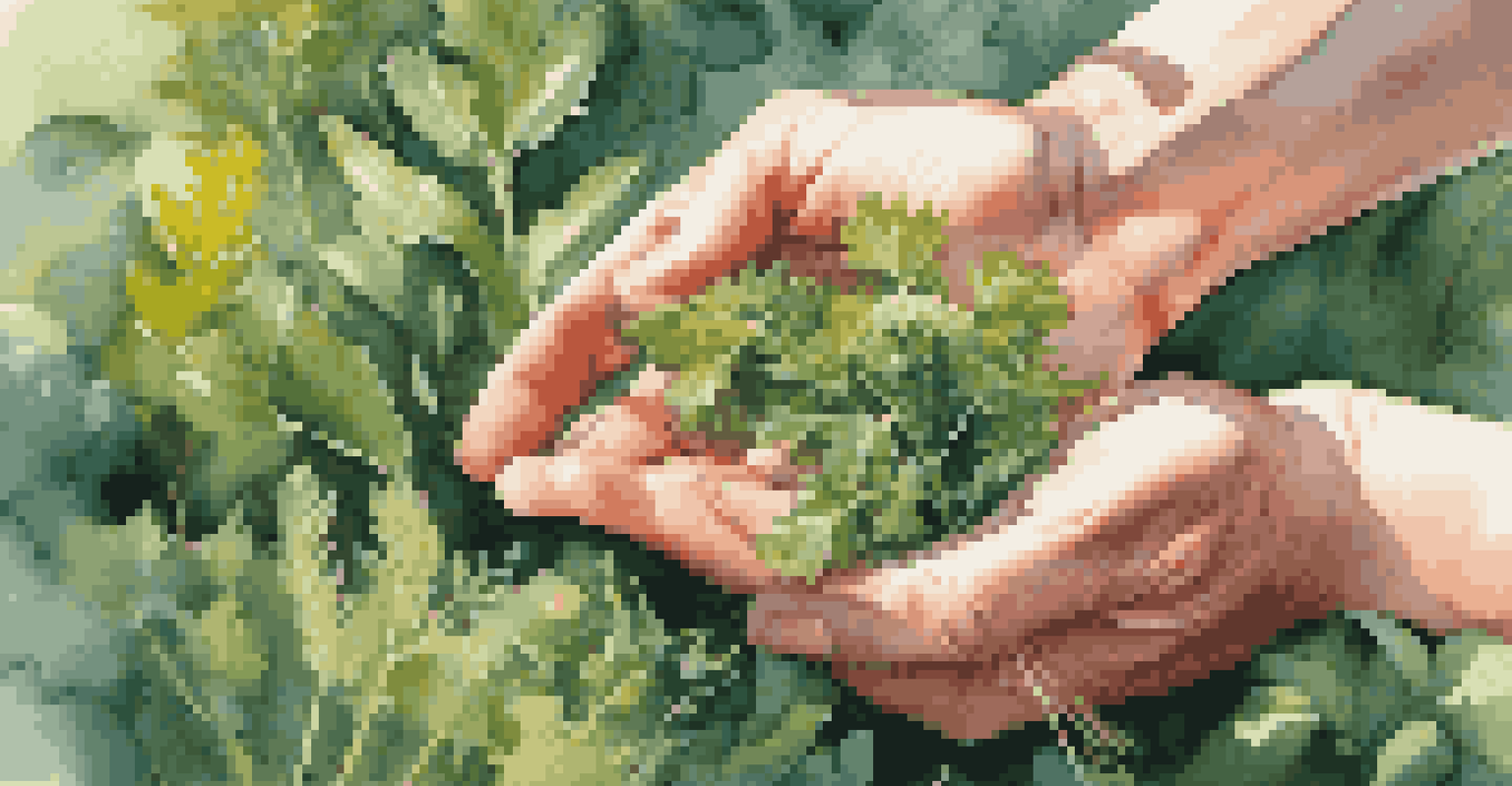Foraging for Wild Spices: Enhance Your Culinary Skills

Introduction to Foraging: A Culinary Adventure
Foraging is more than just a trendy hobby; it’s an adventure that connects you with nature. Imagine stepping outside your door and finding flavorful spices growing in your backyard or local park. This practice not only enhances your culinary skills but also deepens your appreciation for the environment. By learning to identify edible plants, you can elevate ordinary dishes into extraordinary culinary creations.
Foraging is about connecting to the land and understanding the cycles of nature—a journey of discovery that enhances our culinary experience.
The thrill of foraging lies in uncovering hidden gems in the wild, from wild garlic to fragrant thyme. These ingredients are often fresher and more vibrant than what you’ll find in the supermarket. Plus, the sense of accomplishment that comes from gathering your own spices adds a unique flavor to your cooking. It’s a journey that brings excitement to your kitchen and encourages sustainability.
As you embark on your foraging journey, it’s essential to approach it with curiosity and respect. Start by researching local edible plants and familiarize yourself with their characteristics. Remember, foraging is not just about the spices you gather; it’s also about experiencing the beauty of nature and understanding the ecosystems around you.
Essential Tips for Safe Foraging
Safety is paramount when it comes to foraging. Always ensure that you can positively identify a plant before consuming it, as some edible plants have toxic lookalikes. A handy tip is to invest in a good foraging guidebook or download a reputable app that can help you distinguish between safe and unsafe options. The more knowledge you gain, the more confident you’ll become in your foraging endeavors.

In addition to identification, consider the locations where you forage. Avoid areas that may be contaminated with pesticides or pollutants, such as roadsides or industrial sites. Opt for parks, nature reserves, or your own garden, where you can find a bounty of wild spices without the risk of harmful chemicals. This not only ensures your safety but also supports local biodiversity.
Foraging Connects You with Nature
Engaging in foraging enhances your culinary skills while fostering a deeper appreciation for the environment.
Lastly, always forage ethically. This means taking only what you need and leaving enough for wildlife and the plant to regenerate. By practicing responsible foraging, you contribute to the sustainability of the ecosystem, ensuring that future generations can enjoy these natural treasures as well.
Popular Wild Spices to Forage
There’s a world of wild spices waiting to be discovered, each with its unique flavor profile. For instance, wild garlic, which tastes like a milder version of its cultivated counterpart, can be used in everything from pesto to soups. Similarly, mustard greens offer a peppery kick that can elevate salads and sautés, making them a must-have in your foraging repertoire.
The best spice is the one that you gather yourself—nothing compares to the flavor of food made with love and knowledge of the land.
Another exciting option is the vibrant and aromatic sumac, known for its tangy flavor. Often used in Middle Eastern cuisine, it can add a zesty touch to meats, salads, and marinades. Additionally, consider foraging for dill, which can be found in the wild and adds a fresh, herbal note to dishes like pickles or fish.
As you explore the world of wild spices, keep an open mind and be willing to experiment. Each plant can bring a new dimension to your cooking, transforming familiar dishes into something extraordinary. The key is to embrace the process and enjoy the flavors that nature has to offer.
How to Incorporate Wild Spices into Your Cooking
Once you’ve gathered your wild spices, the next step is to incorporate them into your cooking. Start by using them as a garnish to enhance both flavor and presentation. A sprinkle of fresh wild herbs can instantly elevate a simple dish like roasted vegetables or grilled meats, adding a touch of color and freshness.
You can also experiment with infusing oils or vinegars with your foraged finds. For instance, adding wild garlic to olive oil creates a delicious infused oil perfect for drizzling over salads or dipping bread. Similarly, infusing vinegar with wild herbs can create a flavorful base for dressings and marinades that will impress your guests.
Safety is Key When Foraging
Always ensure proper identification of plants and forage ethically to protect both your health and local ecosystems.
Don’t shy away from using these spices in traditional recipes, either. Replace store-bought herbs with your foraged counterparts in soups, stews, and sauces for a fresher taste. This not only enhances the flavor but also adds a personal touch to your culinary creations, showcasing your unique foraging adventures.
Preserving Your Foraged Spices for Longevity
To make the most of your foraging efforts, it’s essential to preserve your wild spices. Drying is one of the simplest methods; simply hang them in a cool, dark place until they lose moisture. Dried spices can be stored in airtight containers and used throughout the year, allowing you to enjoy the flavors of your foraging adventures long after the season has passed.
Another preservation technique is freezing. Chopping and freezing your wild herbs in ice cube trays with a little water or oil can create convenient flavor bombs. These can be easily added to soups, stews, or stir-fries, giving your dishes a burst of freshness even in the dead of winter.
Lastly, consider making your own herbal blends or seasoning mixes using your foraged spices. This not only provides a unique flavor profile but also makes great gifts for friends and family. By preserving your foraged spices, you keep the spirit of your culinary adventures alive all year round.
The Joy of Sharing Foraged Ingredients
One of the most rewarding aspects of foraging is sharing your finds with others. Whether it’s hosting a dinner party featuring dishes made with your wild spices or gifting homemade spice blends, sharing brings a sense of community and connection. It allows you to showcase the flavors of the wild and inspire others to embark on their own foraging journeys.
You might even consider organizing a foraging workshop or joining local foraging groups. This not only helps you learn more about wild spices but also fosters relationships with fellow nature lovers. The conversations and experiences shared during these outings can lead to lifelong friendships and a deeper appreciation for the natural world.
Sharing Foraged Finds Builds Community
Sharing your foraged ingredients not only showcases your culinary adventures but also inspires others to embrace sustainable practices.
Moreover, sharing your foraged ingredients can spark curiosity and encourage others to explore sustainable practices. By introducing friends and family to the joys of foraging, you contribute to a growing movement of people who value fresh, local, and environmentally friendly food sources.
Conclusion: Embrace the Foraging Lifestyle
Embracing the foraging lifestyle opens up a world of culinary possibilities. It encourages you to connect with nature, explore new flavors, and enhance your cooking skills. As you gather wild spices, you not only improve your culinary repertoire but also develop a deeper understanding of the ecosystems that sustain us.
Foraging can be a transformative experience, shifting your perspective on food sourcing and encouraging sustainable practices. By choosing to forage, you contribute to a more environmentally friendly approach to cooking and eating. It’s a journey that fosters mindfulness and appreciation for the ingredients that grace our tables.

So, why not take the plunge? Grab a basket, research local edible plants, and start your foraging adventure today. With each new spice you discover, you’ll find yourself not only a better cook but also a more engaged and conscious member of your community.